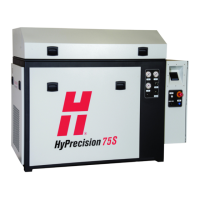166 HyPrecision 50S/60S/75S Operator Manual 808690
7 – Troubleshooting
Troubleshooting
Hydraulic fluid
Low pressure
The most common causes of low hydraulic fluid pressure are a leak from a fitting or a hose in the hydraulic system
and the loss of hydraulic fluid during routine maintenance.
A float switch in the hydraulic fluid tank causes an alarm when the hydraulic fluid level is too low.
If the hydraulic fluid pressure is low:
Examine the pump for hydraulic fluid leaks. Pay attention to these areas:
Hydraulic fluid tank access cover
Hydraulic connections
Valves
Top and bottom decks
Make sure that the hydraulic fluid level is at the top mark on the sight gauge. Add hydraulic fluid, if necessary.
Refer to page 78 for instructions.
High temperature
A sensor in the hydraulic fluid tank monitors the hydraulic fluid temperature with 3 switches. One switch closes
at 45.0°C (113°F), 1 switch opens at 55.0°C (131°F), and 1 switch opens at 65.0°C (149°F).
The optimum operating temperature for hydraulic fluid in this system is 40.6°C (105°F) to 46.1°C (115°F). If the
temperature is outside of this range, adjust the hydraulic fluid temperature. Refer to page 82 for instructions.
High altitude and high ambient temperatures can affect the temperature of hydraulic fluid. Fluid that is too cool is
thick and causes increased friction and poor lubrication. Fluid that is too hot is thin, which accelerates wear on
the parts, increases the formation of sludge, degrades the fluid, and decreases lubrication and protective
qualities.
Fault/warning Stack light Result
Low hydraulic fluid Red
The intensifier turns off.
The pump turns off.
Fault/warning Stack light Result
The hydraulic fluid temperature is equal to
or higher than 55.0°C (131°F)
Amber
The intensifier continues running.
The pump continues running.
The hydraulic fluid temperature is equal to
or higher than 65.0°C (149°F)
Red
The intensifier turns off.
The pump runs in cooling mode for 3
minutes. If the temperature stays at or
higher than 65.0°C (149°F), the pump
turns off.

